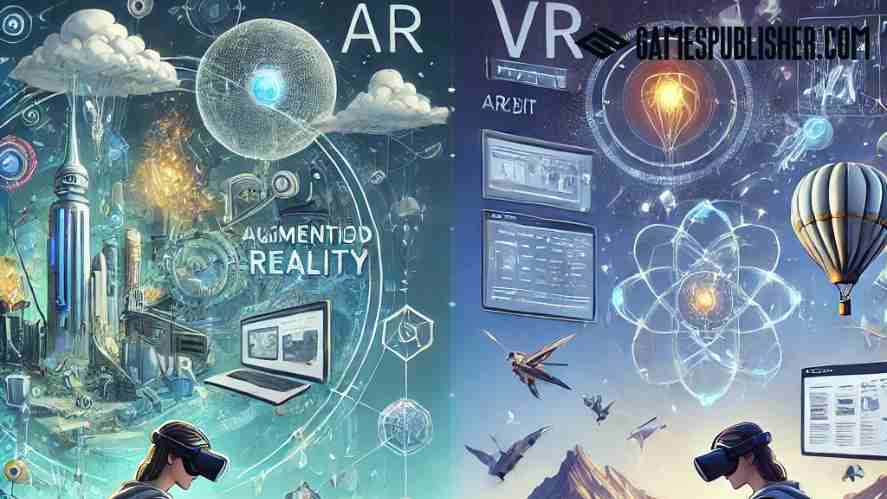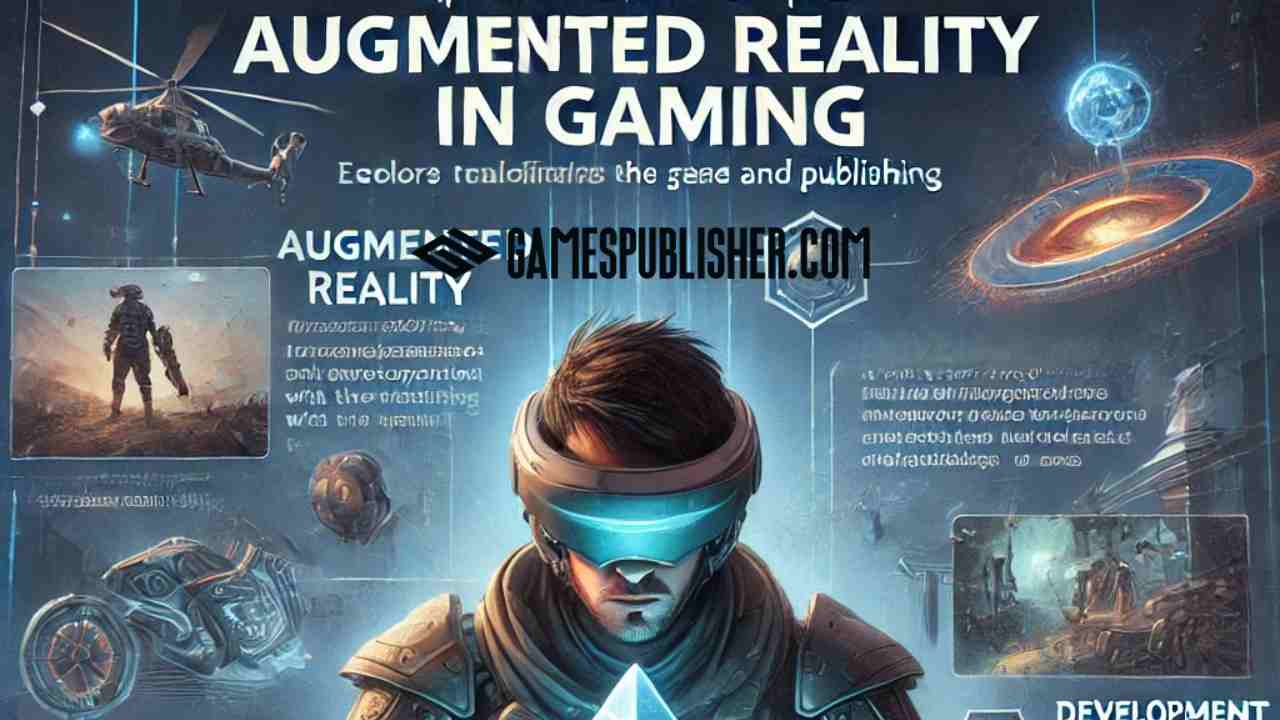Augmented Reality technology places digital layers on top of the natural environment, making it and the computer-generated world nearly indistinguishable.
In addition to creating new game genres, Augmented Reality can improve the existing ones and considerably facilitate video game developers’ work.
In this article, we’ll explore the ability of this technology, how it will revolutionize the development and publishing of games, and the unknown potential it brings to video gaming.
Understanding Augmented Reality (AR)
Augmented Reality (AR) is not only about catching Pokémon. It’s a technological revolution transforming the gaming arena and merging the virtual and real worlds.
Thus, games implemented in the framework of Augmented Reality cause experiences that navigate a set of effects through how we play, create, and engage with games.
Definition and Basics
So, what is Augmented Reality?
Many people misunderstand the difference between AR and VR.
Although both are types of virtual reality technology, AR and VR work in entirely different ways.
While VR helps users to walk to worlds that do not exist, AR adds digital information to the natural physical environment.

This fundamental difference ensures that Augmented Reality falls under a much more expansive category than VR and can be applied to games, education, retail, and many others.
AR experiences are always a result of the integration of its related hard wares and soft wares.
Smartphones and tablets with cameras, sensors, and sufficient computing power are widely used as platforms for augmented-reality games.
These devices utilize complex equations to identify the user’s surroundings. Therefore, they can locate objects in the real world as though they were virtual.
History and Evolution
When it comes to AR, many people misunderstand that they have emerged with technological advancements in recent years.
The reality is quite the opposite.
AR’s inception with a Head-Mounted display goes back to the 1960s, as seen in Ivan Sutherland’s work, Sword of Damocles.

However, early research and development of Augmented Reality also gave way to difficulties in popularity because they were costly to develop. Plus, the technology was not advanced enough to support the application.
The best-known AR games, especially Pokémon GO, became a cultural phenomenon of AR gaming by implementing geographical Augmented Reality through the smartphone.
This success paved the way for more developments and risky investments in Augmented Reality technology, bringing impressive improvements to its game and other fields.
Impact of AR on the Gaming Industry
Through Augmented Reality, gaming is being taken to a new level where the real world becomes a stage and playground.
With the infusion of the virtual environment into real life, AR games offer more than the confines of traditional gameplay, which is essential in the actual setting.
This engagement has led millions to become more involved with the game and its elements, such as Pokémon GO.
This is not considered to be a mere indulgence of a specific class at a particular stage in the evolution of society.
AR games are slowly finding their way into the market among players, and hence, the market is a good niche for game developers/publishers.

Namely, the popularity of devices compatible with AR and further development of Augmented Reality technologies proved that the market of AR games will expand at an excellent rate.
This has enormous potential for developers who wish to experiment, create new things, and tell new stories based on the mechanics of reality in the world.
Other ways to generate revenues include sales of games that are not directly related to gaming, sale of in-game reusable items, regular service fees or subscriptions, and advertisement space.
That said, AR has a lot of opportunities for marketing and new methods of cooperation with brands and extraordinary ventures.
Therefore, the ways to earn money in the constantly developing AR game market are endless.
AR Game Development
Creating mobile AR games means creative thinking and profound knowledge.
It’s defined as advancing the genre’s development and exploring its application at the intersection of game design and technology.
Tools and Platforms
Various practical tools and platforms support AR game development.
Each tool fits different levels of skills and ideas for the projects you are to create, providing a set of essentials for AR.
ARKit
Apple’s ARKit is the toolkit for developing such applications on iOS devices.
It covers solutions for motion tracking, environment understanding, and rendering, allowing developers to quickly put the virtual content into the actual space.
Since ARKit is relatively easy to use, it can be used by both beginners and experienced specialists.
ARCore
Google ARCore is an AR application programming interface provided by Google for Android gadgets.
Like ARKit, it includes essential motion capture, scene analysis, and light estimation tools.
Because ARCore is portable and well-documented, the Android platform’s developers have nothing to lose when considering the framework for use.
Unity
Unity is possibly the most popular and flexible game engine today and has warmly welcomed Augmented Reality.
The AR foundation package in Unity helps with Augmented Reality development because it offers a single framework for all the platforms.
Due to the wealth of resources, ease of use, and constant interaction with the members, Unity is perfect for any AR game developer.
Unreal Engine
Due to its detailed visualization and various features, Unreal Engine can be utilized to develop intricate Augmented Reality applications.
Implementing a game in Unity rather than in ARCore might be easier.
However, if you aim to make something more flexible and performant, then ARCore is the best choice in mobile AR gaming.
Designing AR Games
There is always a way to build captivating games with equal creativity and skills.
Here are some principles to keep in mind:
- Multiplayer Interaction: Permitting players to interact in shared augmented space for cooperative and competitive play.
- Increased Realism: Make a realistic environment to grab an individual’s attention.
- Educational Potential: Gamify learning and make it fun by placing info over the physical world.
- Marketing Opportunities: Target consumers with interactive and engaging campaigns and branded experiences.

Developing Augmented Reality games presents unique challenges that require careful consideration and innovative solutions:
- Tracking and Calibration: Properly tracking and calibrating the user’s movement is crucial in Augmented Reality. This includes the adjustment of such factors as algorithms, sensors, etc.
- Performance Optimization: The disadvantage of AR Games is that they consume a lot of battery energy. So, game developers require striking this balance between performance and power consumption to find sustainable gameplay.
- Seamless Integration: The virtual environment must complement the actual environment to engage the player.
To overcome these challenges, AR game developers can adopt the following strategies:
- Leveraging Advanced Tracking Technologies: Enhancing tracking quality with the help of modern technologies like SLAM (Simultaneous Localization and Mapping) can be very helpful in the case of Augmented Reality tracking precision.
- Optimizing Assets and Code: Effective management of game assets and code optimization can help reduce device load and improve overall performance.
- Thorough Testing and Iteration: This is especially significant since getting errors in tracking or performance can cause problems in other devices and conditions.
- Prioritizing User Experience: Canceling motion sickness is possible by reducing its impact with concepts like easy-to-handle GUI and controllers.
Case Studies
Pokémon GO pointed to the potential of Augmented Reality in nudging people to get out and move around in the physical world.
Likewise, Jurassic World Alive inherited viewers’ obsession with dinosaurs, providing a riveting new Augmented Reality playing field for all age groups.
These examples illustrate how AR can design stimulating experiences and merge between real life and digital ones.
So, AR developers can tap into such successful examples and shift the definition of entertainment beyond itself.
Technological Challenges and Solutions
Despite the great opportunities, the AR infrastructure itself has several technological problems that game developers must address.
They mainly focus on issues connected with the device’s hardware aspects and the software creation’s complexity.
Hardware Limitations
The current generation of mobile devices has some limitations regarding AR gaming.
The product’s battery is still an issue because AR experiences are rather demanding and tend to consume battery power quickly.

The amount of processing power available can also be a constraint when many polygons are used in rendering or graphics or when there are real-time interactions with the 3D Environment.
What has not advanced as much is the hardware, but there is hope for improvements in this aspect.
Better and more energy-efficient processors, improved batteries, and state-of-the-art AR chips are on the way, implying reliable immersion intensity.
Moreover, more advanced Augmented Reality wearable items like smart glasses could change the AR game paradigm.
Software and Development
On the software front, developers face challenges ensuring smooth performance and intuitive user experiences.
Tracking accuracy, latency issues, and environmental understanding require continuous refinement.
Optimization techniques, such as efficient asset management, code optimization, and adaptive rendering, can help mitigate these challenges.
Nonetheless, developers will be able to design AR games that are not only fun and entertaining to the users but also designed and developed with technical accuracy and designed to be played by a large audience.
Moreover, the future of AR gaming looks even more promising.
Consumers will witness even more ground-breaking scenarios that Augment Reality more effectively when the technologies progress.
Future of AR in Gaming
AR gaming is not fully developed but still holds vast potential for development.
Certain new tendencies and technologies can bring a new perspective into gaming and its practical application shortly after the line between the real and the virtual world disappears.
Another good news in the development of AR gaming is that technology such as artificial intelligence (AI) and machine learning (ML). They are gradually incorporated into the game development process.
Moreover, with the help of such networks as 5G, the connections will become even more beautiful and smooth. This gives the start to multiplayer AR games with real-time interaction with players.
Another trend is the emergence of Augmented Reality wearables, including smart glasses and headsets.
These devices seem to provide a better immersive and untethered AR experience that is less dependent on smartphones and tablets.

In the future, as we see new improvements in Augmented Reality, we are sure to get new inventions that will revolutionize the concept of gaming.
Picture the living room filled with games with AR executed through a smart home where one turns into a battleground or a mythical land.
Similarly, AR could transform social gaming as people can play in actual environments and possibly interact with game characters and objects.
Consider going to a virtual concert with friends in a local park or on a treasure hunt in your city with friends.
The future of AR gaming is only defined by what can be created by the masses.
The advancements in technology indicate that, in the future, there will be more advancements in terms of immersion, interactivity, customization, and social aspects of AR games.
The next decade will be an exciting time for both developers of Augmented Reality video games and gamers as the world explores the frontier.
Conclusion
Augmented Reality will be capable of transforming the gaming segment by providing unprecedented levels of gaming experience and creativity.
The fact that it blurs the line between the actual world and the virtual one offers vast arrays of opportunities for game developers, video game publishers, and players.
The advancement in Augmented Reality is significant, which means that more mind-blowing games will be developed for near-reality levels.
Loading survey...

